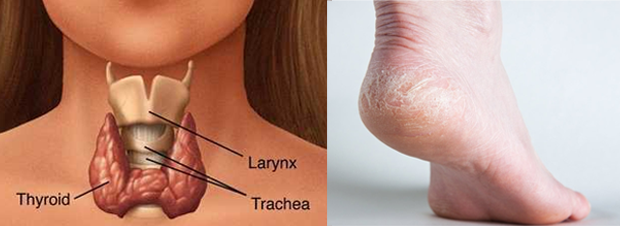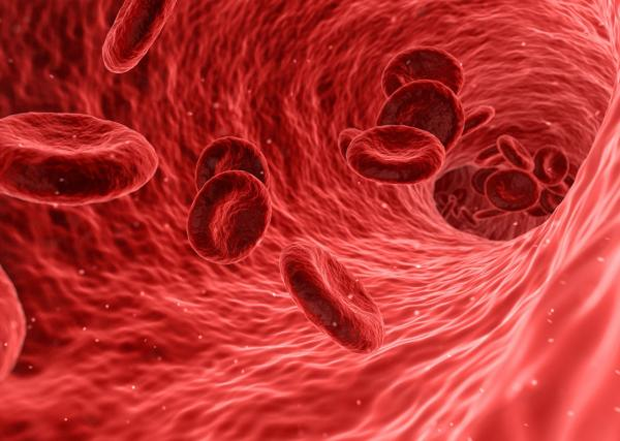|
Your feet are amazing diagnostic tools that your doctor can use as clues
potentially pointing to a whole host of health problems.
But you don't need to be a doctor to understand what your feet are
saying about your health — you just need to know what warning signs to
look for.
If you notice any of the following telltale signs or symptoms in your
feet, you may want consult your doctor:
|
|
 |
|
Dry, Flaking Skin
If the skin around your heel or on the ball of your foot is dry,
cracked, or flaky, it may be a warning sign of a thyroid condition. Your
thyroid gland produces hormones that control your metabolic rate, blood
pressure, tissue growth, and nervous system functions. Dry skin can
signify a problem with your thyroid.
Obviously, dry skin can also be the result of many less serious health
issues, and sometimes your skin dries out simply because of changes in
the weather. But if you notice that the skin on your feet is dry, and
you also have symptoms like weight gain, numbness in your hands, or
vision problems, set up an appointment with your doctor. |
|

|
|
Balding Toes
While toe hair is more common and visible in men, women generally have
fine hairs on their toes as well. If you notice that your toes are
losing a little bit of hair, or if they've gone completely bald, it
could be a sign of poor blood flow. One cause of insufficient blood
supply to the feet and toes is peripheral arterial disease, or PAD for
short.
When plaque builds up in the arteries of your legs, blood flow can be
restricted and PAD can set in. If left untreated, PAD could lead to a
heart attack or stroke, or even put you at risk for amputation.
If you suspect PAD, see a doctor. You can combat symptoms of PAD by
giving up smoking, maintaining a balanced diet, getting regular
exercise, and managing other health conditions, like hypertension or
diabetes, that can contribute to the condition. |
|

|
|
Foot Numbness
Like toe baldness, foot numbness due to a lack of blood flow in the area
can be a sign of PAD. You've probably experienced numbness in your feet
if you sat in one position for too long, or if you fell asleep at an
awkward angle. But if it happens regularly or while you're active, it’s
a problem you shouldn't ignore.
Foot numbness is also one of the more common symptoms of peripheral
neuropathy related to type 2 diabetes, which affects millions of people.
Diabetes complicates blood flow to your feet, which means wounds or cuts
may take a longer time to heal, leaving you susceptible to infection.
If you have irregular bouts of foot numbness, and wounds on your feet
just don't seem to heal, talk to a doctor. To promote healthy blood flow
and help prevent type 2 diabetes, be sure to get regular exercise and
reach for healthy foods. |
|
 |
|
Black Spots or Lines Under Your Toenails
When someone steps on your toes or you drop a heavy object onto your
foot, you’ll most likely have some toenail discoloration. Dark
discoloration under your toenail isn't typically concerning if you know
what caused it.
But if you notice discoloration — or black and brown lines — under a
toenail and you don't remember injuring your toe, you might want to talk
to your doctor. Dark, vertical lines under a toenail could be a sign of
a hidden melanoma. We’re getting better at fighting cancer every day,
but hidden melanomas often go overlooked and untreated.
Toenail discoloration could also be caused by a fungal infection, and
while that's much less severe than a potential cancer diagnosis, you
should not ignore it. My advice is to check your toenails for
discoloration every time you cut your nails.
|
|
 |
|
Morning Foot Pain
A number of patients have asked me why they experience foot pain in the
morning. Burning or shooting foot pain that happens when you take your
first few steps out of bed can indicate of a number of potential issues.
First, it could be a sign of rheumatoid arthritis (RA), which inflames
your joints and can cause pain even in the small joints of your feet.
You can control foot pain and other of rheumatoid arthritis symptoms
with medication and regular exercise; ask your doctor about this if you
haven’t already.
It's also possible that your morning foot pain is caused by plantar
fasciitis, a condition caused by inflammation in the thick band of
tissue that connects your heel to your toes; the band remains in a
contracted state while you sleep. When you take your first steps of the
day, the tissues stretch. If you’re dealing with inflammation, you’ll
notice pain. Stretching your feet before you get out of bed, or doing
foot-strengthening exercises, can help prevent the onset of plantar
fasciitis.
Lastly, morning foot pain could be caused by a muscle cramp. As with
plantar faciitis, you can avoid foot cramps by stretching your foot
muscles before you get out of bed.
|
|
 |